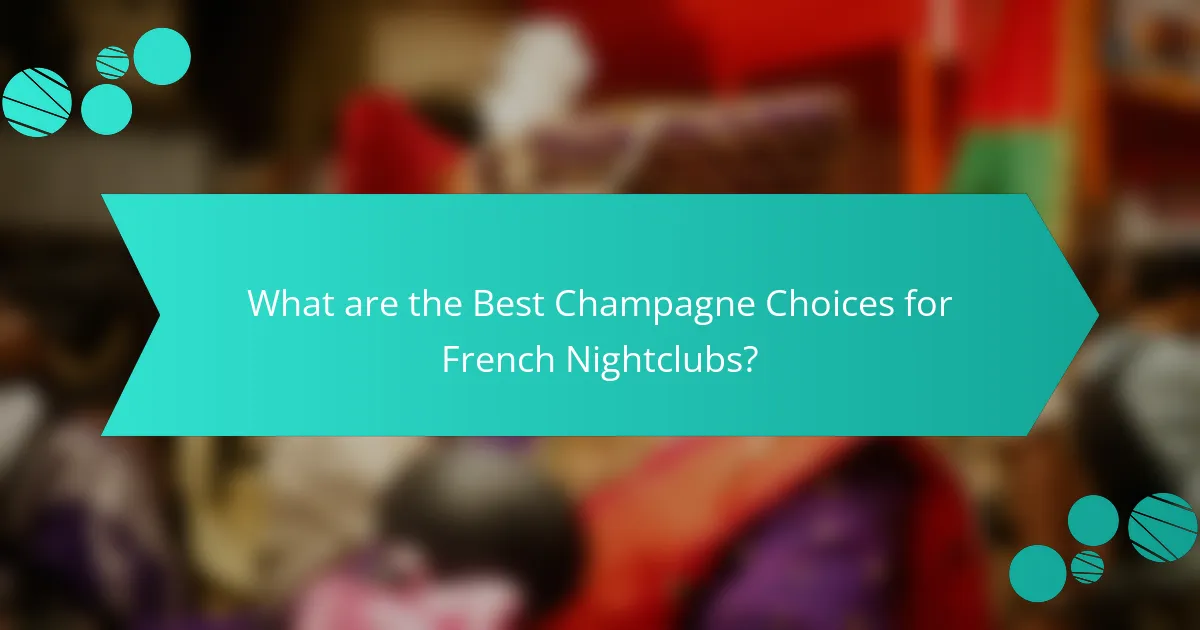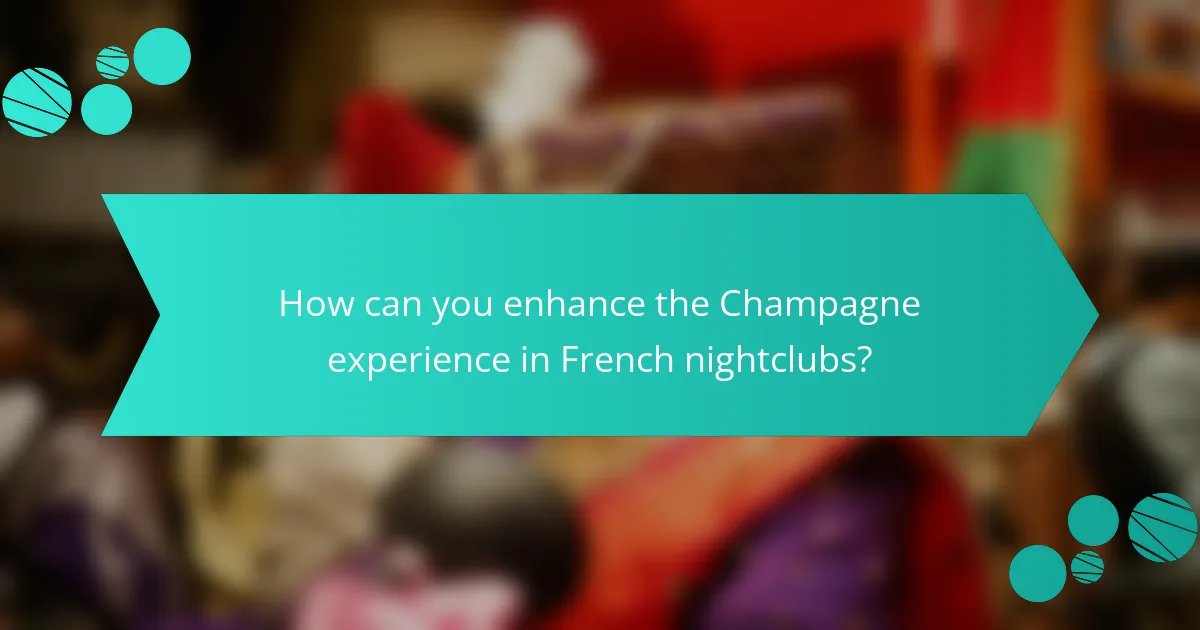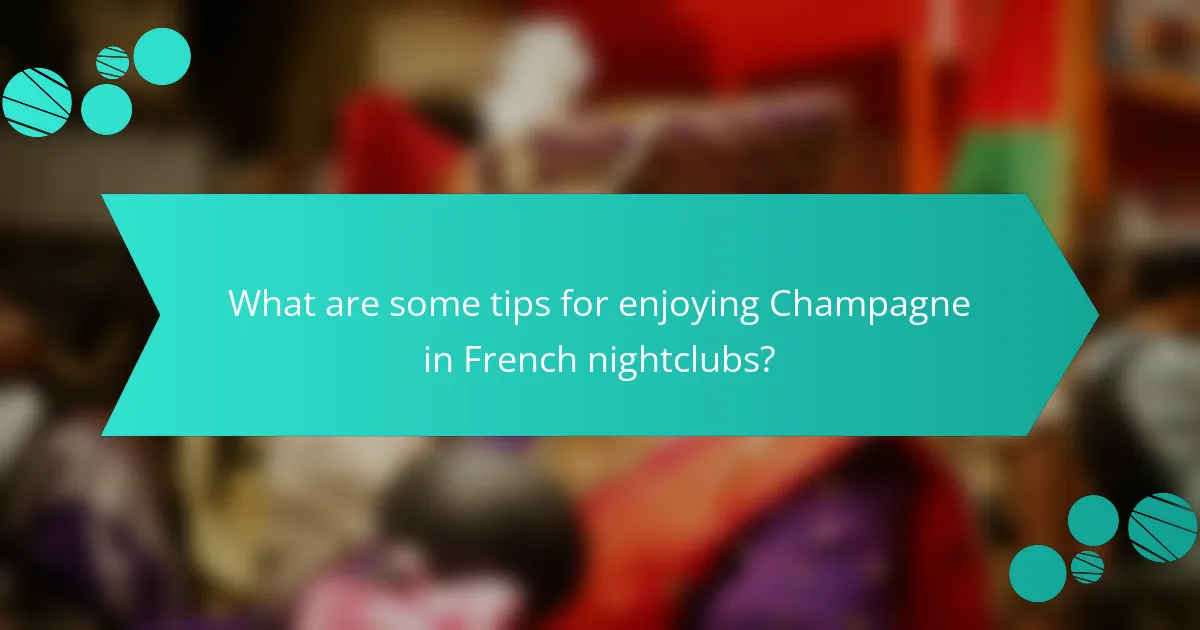The article focuses on the best champagne choices for French nightclubs, highlighting three premier brands: Moët & Chandon, Veuve Clicquot, and Dom Pérignon. Each champagne is characterized by distinct taste profiles, with Moët & Chandon offering vibrant fruit flavors, Veuve Clicquot providing a rich, toasty experience, and Dom Pérignon representing luxury with its complex flavors. The article also discusses optimal serving temperatures, recommended food pairings, and the importance of ambiance and knowledgeable staff in enhancing the champagne experience. Key suggestions include serving champagne chilled between 45°F and 50°F and pairing it with gourmet appetizers to elevate enjoyment in the nightlife setting.

What are the Best Champagne Choices for French Nightclubs?
The best champagne choices for French nightclubs include Moët & Chandon, Veuve Clicquot, and Dom Pérignon. Moët & Chandon is known for its vibrant fruit flavors and is a popular choice for celebrations. Veuve Clicquot offers a rich, toasty profile and is favored for its consistent quality. Dom Pérignon is a prestigious vintage champagne with complex flavors, ideal for luxury experiences. These champagnes are often selected for their ability to enhance the nightlife atmosphere in France. Their popularity is supported by sales data, showing they are frequently ordered in upscale venues.
How do different types of Champagne vary in taste profiles?
Different types of Champagne vary in taste profiles due to their grape compositions and production methods. Non-vintage Champagne typically has a balanced taste, often featuring fruity and floral notes. Vintage Champagne, made from grapes harvested in a single year, tends to have more complexity and richness.
Blanc de Blancs Champagne is exclusively made from Chardonnay grapes, resulting in a lighter, crisper profile with citrus and green apple flavors. Conversely, Blanc de Noirs Champagne uses Pinot Noir and Pinot Meunier grapes, offering a fuller body and berry notes.
Rosé Champagne is produced by blending red and white grapes or by allowing skin contact, giving it a fruity and floral character with a hint of red fruit. Each type of Champagne’s taste is influenced by factors such as terroir, aging, and dosage, which affects sweetness levels.
What are the key flavor notes found in popular Champagne brands?
Popular Champagne brands exhibit key flavor notes such as citrus, apple, and pear. These fruity notes are often complemented by floral hints like jasmine and honeysuckle. Additionally, many Champagnes reveal toasty characteristics from aging, including brioche and almond. Some brands also showcase mineral notes, providing a crisp finish. For example, Moët & Chandon often features green apple and citrus, while Veuve Clicquot is known for its rich, toasty profile. Taittinger typically highlights floral and fruity aromas, enhancing its elegance. These flavor profiles contribute to the overall tasting experience of Champagne.
How does the production method influence the taste of Champagne?
The production method significantly influences the taste of Champagne. Traditional methods, such as méthode champenoise, involve secondary fermentation in the bottle. This process creates fine bubbles and contributes to the wine’s complexity. The aging on lees enhances flavors, adding toasty and nutty notes.
Different grape varieties also affect the taste profile. Chardonnay lends elegance and acidity, while Pinot Noir adds body and fruitiness. The dosage, or sugar addition, during disgorgement can balance acidity and sweetness.
Moreover, the terroir, or geographical influence, shapes the flavor characteristics. Regions like Montagne de Reims impart unique mineral qualities. Overall, these production elements combine to create diverse taste experiences in Champagne.
What factors should be considered when selecting Champagne for nightclubs?
When selecting Champagne for nightclubs, consider taste profile, brand reputation, and price point. The taste profile should align with the preferences of the clientele. Popular styles include Brut and Rosé, which are often favored in nightlife settings. Brand reputation is crucial; established brands like Moët & Chandon or Veuve Clicquot are recognized for quality. Price point affects customer perception and sales; premium options can enhance the nightclub’s image. Additionally, consider the bottle presentation, as visually appealing bottles attract attention. Serving temperature is also important; Champagne should be chilled to enhance flavor and refreshment. Each of these factors contributes to an enjoyable experience for patrons.
How does the ambiance of a nightclub affect Champagne choices?
The ambiance of a nightclub significantly influences Champagne choices. A vibrant, high-energy environment often leads patrons to select more popular, visually appealing brands. These brands typically include well-known names that are associated with celebration and luxury. In contrast, a more relaxed or intimate setting may encourage choices of artisanal or boutique Champagnes. These options often offer unique flavors and are less mainstream. Additionally, lighting and décor can affect the perceived value of different Champagne options. For instance, dim lighting may enhance the allure of premium selections. Ultimately, the overall vibe impacts both the brand and style of Champagne chosen by consumers.
What role does price play in selecting Champagne for nightlife?
Price significantly influences the selection of Champagne for nightlife. Higher-priced Champagnes often signify quality and prestige. Consumers associate price with taste and exclusivity. Nightclubs frequently offer premium Champagne to enhance the ambiance. A study by the Journal of Consumer Research shows that price affects perceived value. Patrons may choose expensive options to showcase status. Additionally, price can dictate availability in nightlife venues. Ultimately, price serves as a key factor in Champagne selection for nightlife experiences.

How can you enhance the Champagne experience in French nightclubs?
Enhancing the Champagne experience in French nightclubs involves a combination of factors. First, serving high-quality Champagne at optimal temperatures enhances its flavor. The ideal serving temperature for Champagne is between 45°F and 50°F. This temperature range allows the aromas to fully develop.
Second, offering a selection of diverse Champagne brands can cater to different tastes. Including both vintage and non-vintage options provides a broader appeal. Third, pairing Champagne with gourmet appetizers can elevate the overall experience. Foods like oysters, caviar, and fine cheeses complement Champagne’s flavors.
Fourth, creating an engaging atmosphere with proper lighting and music enhances enjoyment. A lively ambiance encourages social interaction and appreciation of the drink. Lastly, knowledgeable staff can provide insights into the Champagne selection. This adds an educational aspect that enriches the guest experience.
What are the best food pairings for Champagne in a nightclub setting?
Oysters are one of the best food pairings for Champagne in a nightclub setting. The brininess of oysters complements the acidity of Champagne. Caviar is another excellent choice, enhancing the luxurious experience. Fried foods, like calamari or tempura, balance the crispness of the bubbles. Cheese platters featuring soft cheeses, such as brie, pair well with Champagne’s effervescence. Light appetizers, such as shrimp cocktails, also work effectively. These pairings are popular in nightlife due to their ability to elevate the drinking experience.
Which appetizers complement the taste of different Champagne types?
Oysters complement the taste of brut Champagne. The saltiness of oysters enhances the crispness of brut. Caviar pairs well with vintage Champagne. The richness of caviar balances the complexity of vintage varieties. Soft cheeses, like Brie, suit rosé Champagne. The creaminess of Brie matches the fruity notes of rosé. Fried foods, such as tempura, work with demi-sec Champagne. The sweetness of demi-sec contrasts nicely with the savory flavors of fried dishes. Charcuterie boards enhance various Champagne types. The variety of meats and cheeses provides a range of flavors that match well with Champagne.
How does pairing Champagne with dessert elevate the experience?
Pairing Champagne with dessert elevates the experience by enhancing flavors and creating a balanced palate. The natural acidity and effervescence of Champagne complement the sweetness of desserts. This contrast prevents desserts from being overly rich or cloying. Champagne’s complex flavor profile can highlight various dessert elements, such as fruit, chocolate, or cream. Additionally, the bubbles cleanse the palate, making each bite more enjoyable. Studies show that sparkling wines, like Champagne, increase perceptions of sweetness in food. This pairing can transform a simple dessert into a luxurious dining experience.
What are the ideal serving temperatures for different Champagne styles?
The ideal serving temperatures for different Champagne styles vary. Non-vintage Champagne is best served between 45°F and 50°F (7°C to 10°C). Vintage Champagne should be served slightly warmer, around 50°F to 55°F (10°C to 13°C). Rosé Champagne is optimal at 45°F to 50°F (7°C to 10°C).
These temperatures enhance the flavors and aromas of each style. Serving Champagne too cold can mute its taste. Conversely, serving it too warm can exaggerate sweetness and diminish its refreshing qualities.
How does serving temperature impact the flavor profile of Champagne?
Serving temperature significantly impacts the flavor profile of Champagne. When served too cold, typically below 6°C (43°F), the flavors can become muted. This can mask the wine’s complexity and aromatic nuances. Conversely, serving Champagne at a warmer temperature, around 8-10°C (46-50°F), enhances its aromatic expression. At this temperature, the wine’s fruitiness and toasty notes become more pronounced. Studies show that temperature variations can alter perceived sweetness and acidity levels. Therefore, the ideal serving temperature allows for a balanced and enjoyable tasting experience.
What are the recommended serving temperatures for various Champagne types?
The recommended serving temperatures for various Champagne types are as follows: Non-vintage Champagne should be served at 45-48°F (7-9°C). Vintage Champagne is best at 50-54°F (10-12°C). Rosé Champagne is ideal at 48-52°F (9-11°C). Sparkling wines, such as Crémant, should be served at 45-50°F (7-10°C). These temperatures enhance the flavors and aromas of the Champagne. Serving at the correct temperature ensures an optimal tasting experience.

What are some tips for enjoying Champagne in French nightclubs?
To enjoy Champagne in French nightclubs, choose a high-quality brand known for its taste. Popular options include Moët & Chandon and Veuve Clicquot. Order a bottle to share with friends for a more social experience. Serve Champagne chilled, ideally between 45-50°F (7-10°C). Use proper glassware, such as flutes, to enhance the aroma and flavor. Take small sips to appreciate the complexity of flavors. Pair Champagne with light bites like oysters or cheese for a delightful combination. Stay hydrated by drinking water between servings to maintain your energy. Enjoy the ambiance and music, as the atmosphere enhances the overall experience.
How can you choose the right Champagne for your personal taste?
To choose the right Champagne for your personal taste, consider the sweetness level, style, and flavor profile. Champagne is categorized by sweetness levels, ranging from brut nature (no added sugar) to doux (very sweet). Your preference for sweetness will guide your selection.
Next, identify the style of Champagne you enjoy. Options include non-vintage, vintage, and prestige cuvée. Non-vintage is blended for consistency, while vintage Champagne is made from grapes harvested in a single year. Prestige cuvée represents the highest quality from a producer.
Finally, explore flavor profiles. Champagne can exhibit notes of citrus, apple, brioche, or floral elements. Tasting different varieties will help you discover what resonates with your palate.
Sampling various options at tastings or events can also refine your preferences. The right Champagne aligns with your sweetness preference, desired style, and flavor notes.
What should you look for when tasting Champagne at a nightclub?
When tasting Champagne at a nightclub, look for the aroma, flavor profile, and bubbles. The aroma should be fresh and inviting, often with notes of citrus or toast. The flavor profile should balance sweetness and acidity, providing a crisp taste. The bubbles should be fine and persistent, indicating quality. Additionally, consider the Champagne’s temperature; it should be well-chilled but not too cold. This enhances the tasting experience. High-quality Champagne often has a complex flavor that evolves with each sip. Noting these characteristics can enhance your overall enjoyment.
How can you navigate Champagne menus effectively?
To navigate Champagne menus effectively, start by understanding the different styles of Champagne. The main styles include Non-Vintage, Vintage, Blanc de Blancs, and Blanc de Noirs. Non-Vintage Champagne is a blend of wines from multiple years. Vintage Champagne is made from grapes harvested in a single year. Blanc de Blancs is produced exclusively from white grapes, while Blanc de Noirs is made from black grapes.
Next, consider the flavor profiles associated with each style. Non-Vintage is often fruitier and more approachable. Vintage Champagne tends to be more complex and age-worthy. Blanc de Blancs usually has a crisp and elegant profile, while Blanc de Noirs can be richer and fuller-bodied.
Check the Champagne house and its reputation. Renowned houses often indicate higher quality. Look for specific regions such as Montagne de Reims or Côte des Blancs, known for their distinct terroirs.
Lastly, pair the Champagne with your meal. Light styles complement seafood, while fuller-bodied options work well with richer dishes. Understanding these factors will enhance your dining experience in French nightclubs.
What common mistakes should be avoided when ordering Champagne in nightclubs?
Common mistakes to avoid when ordering Champagne in nightclubs include not knowing the menu options. Familiarity with the available brands and types enhances the ordering experience. Another mistake is failing to check the price before ordering. Nightclub prices can significantly mark up Champagne. Ordering without considering the occasion can lead to inappropriate selections. It’s essential to match the Champagne to the celebration type. Additionally, neglecting to ask for recommendations can result in missed opportunities for better choices. Club staff often have insights into popular or high-quality options. Finally, not specifying preferences can lead to receiving a less desirable Champagne. Clear communication about taste preferences is crucial for satisfaction.
How can overpaying for Champagne be avoided?
Research and compare prices from multiple retailers before purchasing Champagne. This helps identify competitive pricing and avoid overpaying. Look for sales or discounts offered by various stores. Consider purchasing directly from producers or reputable online retailers, which often provide better prices. Pay attention to the Champagne’s brand and quality, as premium labels may come with a higher price tag. Additionally, be wary of markups in nightclubs, which can significantly increase costs. For instance, a bottle that retails for $50 may be priced at $200 in a nightclub. Always verify the price against known retail values to ensure a fair deal.
What are the pitfalls of choosing Champagne based solely on brand?
Choosing Champagne based solely on brand can lead to several pitfalls. This approach often overlooks quality and flavor profiles. Many lesser-known producers offer exceptional Champagne that rivals famous brands. Relying on brand prestige can result in higher costs without corresponding quality. Brand marketing may prioritize image over the actual taste experience. Additionally, personal preferences in taste may not align with popular brands. This can lead to dissatisfaction with the chosen product. Ultimately, focusing solely on brand can limit exploration of diverse and unique Champagne options.
The main entity of this article is Champagne, specifically focusing on the best choices for French nightclubs. It covers popular brands such as Moët & Chandon, Veuve Clicquot, and Dom Pérignon, detailing their taste profiles and production methods. The article also discusses the importance of serving temperatures, food pairings, and the influence of ambiance and price on Champagne selection in nightlife settings. Additionally, it provides tips for enhancing the Champagne experience and navigating menus effectively, while highlighting common mistakes to avoid when ordering.